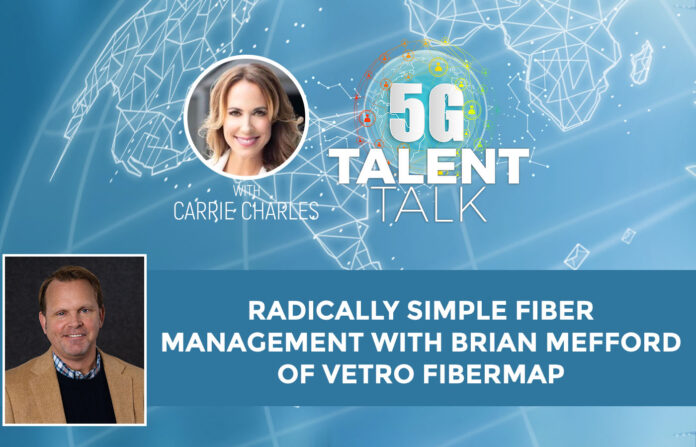Explore the many ways telecommunications can be used as an enabler for entrepreneurial growth and supporting community development. In this episode of 5G Talent Talk with Carrie Charles, we’re joined by Brian Mefford, VP of Broadband Strategy for VETRO FiberMap, to discuss their mission to radically simplify fiber management and drive community advancement.
This engaging conversation explores VETRO FiberMap’s efforts of becoming the hub for all aspects of fiber construction, embracing a wide range of public-private partnerships. Additionally, Brian shares insights into the corporate culture at VETRO, their strategies for addressing the challenges that come with business growth, and how grant funding has changed with the latest technological shifts. Tune in to this insightful episode and join us in shaping the future of telecom through innovative approaches and community development.
—
Watch the episode here
Listen to the podcast here
Radically Simple Fiber Management with Brian Mefford of VETRO FiberMap
I have with me the Vice President of Broadband Strategy for VETRO FiberMap, Brian Mefford. Brian, thanks for joining me. I’m excited about this conversation.
Thank you for having me. I’m excited to be here.
Brian, tell me a little bit about how you got into the broadband space.
It’s a convoluted story. I’ll make it quick. I grew up in Rural Kentucky. I grew up farming in the summers, helping my grandfather farm. I wanted to be a farmer my whole life until I realized it wasn’t going to pencil out quite the way I had planned. I started looking at other places in my family. My dad was a big influence on my career path. He worked at BellSouth for most of his career, 30-some-odd years. Back then, it was a company where he literally started as a switchboard operator and climbed poles at one point. He did basically every possible job you could do in 30 years at that company. He ended up in an interesting place where he was doing government affairs and public-private partnerships.
BellSouth did a project with the University of Louisville that blew my mind even as a pre-teen. It was a partnership to help demonstrate how fiber optics could be used as an enabler for entrepreneurial growth. They had this accelerator that was ahead of its time. I was obsessed with it. I’d meet with the companies and learn about fiber and what this was all about. I learned the new language of HTML when it first came out and things like that. It set my mind on thinking that it’s fascinating that telecom can literally be used for entrepreneurship that then supports the growth of communities. I put that on the shelf, went to school out West, and my wife and I traveled and worked in different parts of the country.
I got a call from my dad at one point early in my career, and he said, “There’s a job you might be interested in back in Kentucky. It’s with a group that’s using technology to support economic development in rural communities.” I thought, “That sounds interesting and familiar.” I did that and came back with a project called Connect Kentucky and turned that into a deep dive into the broadband and infrastructure-driven project where we were focused on how technology can become an enabler for struggling communities.
We ended up doing that successfully. Basically, we did that work in 120 counties in Kentucky. Tennessee, Ohio, and California called, and we knew we had a business to grow. I started a company called Connected Nation, which continues to do great work to this day. At Connected Nation, I first worked with the founder of VETRO, Will Mitchell. Will basically said, “We’re a lot alike. We have a lot of interesting thoughts that we could bring together, and let’s plan on doing that someday.” It worked out, and that happened.
Tell me the story of VETRO FiberMap.
It’s an awesome company. It’s a company that I can start gushing about. I’ve been here for years now. Will and I came together. We started seeing the country go down the path of leaning into public funding for infrastructure, and Will and his cofounder built an awesome product for fiber management. It’s a fiber management system. It was brand new in the way it approached how companies could use technology to plan, design, build, and operate their networks. They grew up around that product of helping small and medium-sized ISPs transition to building fiber networks. We were an innovator at that early stage. People were rubbing pennies together to be able to buy software, as they were trying to get into the fiber game.
We’ve expanded on that product base to build new products, one of which I focus on that supports state broadband offices as they roll out these grant programs. It’s a place for the state broadband office and sub-grantees, as they’re called by NTIA, ISPs communities that are applying for grants. It’s a platform. It’s a place for all of them to come and congregate around the same set of data and to see visually on the map proposals that are being put forward, grants that are being made, the status of projects, managing all of that in one place is the product that we built for the moment.
You are in the center of the action right now. What’s going on in broadband?
It’s exciting. I’ve been in this space for many years, and a lot of us, honestly, who were in this space at that point, got beat down over the years. Not to play pickup here, but you can only go to so many meetings and say the same thing over and over and be a cheerleader for so long. This is high-impact stuff we have to invest in. What never happened for two decades was the investment didn’t follow. It did from the private sector. I should be clear about that. The private sector’s been investing in a big way in this. When we’re talking about investing in places where it’s hard to pencil out a business case without significant subsidy, that was the piece that was missing for two decades.
Many of us tried, and we got some money. There was a previous stimulus that spent $7 billion roughly on infrastructure. Now we’re looking at a combination of programs over the last handful of years where it’s going to approach $150 billion, all in, all said. It’s that realization that this is right. This is real. The impact is important and significant, and life-changing. We have to make it happen for every citizen. The fact that the investment has followed those words that’s the big difference.

What public-private partnerships will be needed to move this initiative forward, this massive initiative?
It’s all of the above. It’s every flavor of public-private partnership that’s been conceived, in my opinion, over the last many years. The spectrum is private only. The capital is available. They can take on the risk themselves alone and then going into the public sector, let’s say a state government or local government providing a capital investment that basically de-risks or lowers the risk, for that same company to go into that market and build and operate a network. You have more of a true partnership where the local or state governments might pay for and be responsible for building the asset and the network.
They partner with an operator, and it’s more of an equal partnership. Going on the other side of the equation, the balance starts tilting towards the public sector all the way over to purely public networks. What we’re seeing is all these things can work in the right situation and with the right ingredients. One thing that gets lost maybe in that explanation, which is hugely significant and goes back to your last question, too, is the role of electric and telephone co-ops in this space. That was a thing that people begged and pleaded for co-ops to get involved in broadband for under a couple of decades.
It makes sense. At that point, before the level of subsidies we’re talking about now, it was hard for them to put broadband on one page and electric on the other and say, “Yes, that’s going to make as much sense.” It didn’t financially and risk-wise. Now with some support there, you’ve got it happening with a lot of electric co-ops across the country. That may be the thing that we look back on as the biggest momentum maker or game changer, however you want to put it. I’m dialed in from my farm in Western Kentucky, and I’m coming at you live on a gigabit connection.

When I say that now, my connection will die in two minutes. Truly it’s our electric co-op that said, “Yes, we can take this on, and it’s our members who are out here struggling.” They made that decision back during the early stages of the shutdown. Now they’ve built out basically to our entire county, tens of thousands of people who didn’t have service before.
You wanted to be a farmer when you were younger, so you are now.
Yes. I’m a fake farmer, is what I am. We do enough to let our kids get their hands dirty and learn how to take care of animals, grow gardens and those types of things. It’s lovely. We love it and can’t imagine being anywhere else.
How will the grant funding change the behavior of builders and operators? Will they be required to do things differently?
It starts with the answer that it depends. It depends on where the company is starting. Let’s take a company that was maybe a regional operator in the past and incrementally building a new network. Maybe they were building copper plants. We will use that scenario. Now, the federal government has multiple programs, particularly BEAD, which is forward-looking and what people are modeling behavior around now. There’s a clear preference for fiber. It’s not the end all be all requirement, but the government’s been clear that that’s the preference.
How that gets worked into FWA, fixed wireless and other solutions is to be determined. They’ve been building that plant incrementally for the last few years and all of a sudden, they need to figure out how do I build fiber and not just meet requirements. For the life cycle of their investment in business with subsidy available, it’s going to make sense for a lot of companies to do that well. There’s that technology shift that’s happening. You’ve got folks in the market who have been in the telecom business for years but are learning a new element to the business. How do you plan fiber?
How do you build investment scenarios? What’s your customer messaging? What and how do you build out? What’s the talent that’s available to make that happen? How do you service and support, maintain, and operate that network over time? There’s learning that’s happening there. At the same time, they’re looking at those subsidies that support mechanisms and realizing anything in life, it comes with strings. It’s not just me out here as an operator investing the capital that I’ve raised, deciding what risk I want to take on. There are a lot of stipulations, requirements, and prescriptions in some cases, so I have to account for that.
An example is reporting. Let’s say first there’s applying for grants. Getting the money is not an inexpensive endeavor. It takes teams to put these grant applications together to understand what the specific state requirements are. There may be local engagement requirements. It’s a fairly sophisticated undertaking. I get the money and now I’m going to invest in fiber and build out to every point that I’ve committed to and then there comes reporting. That’s a whole new element. That is not insignificant.
In the past, I could operate as I choose. In a regular regulated environment, some level of reporting is required, of course, but this is a whole new level of reporting. As an operator, as an ISP, if I win BEAD grant money, I’m going to have to report on the status of what I’ve committed to build at the address level. How far am I into the construction process, what have I built, what services am I offering on that network that I’ve expanded? Who’s taking it and what are they taking? I have to continue that reporting cycle. It’s going to end up being about ten years.
VETRO’s role in all of that is what?
I mentioned a tandem set of products earlier. First and foremost, our core business is in supporting ISPs. We’ve built what we call radically simple fiber management software. What we mean by radically simple is anybody in an organization can use our software. We built it for the CEO of a company to be able to fly in and get a visual of the operation. What I mean by the operation, our software helps with the planning, design, building, construction and ultimately the operation of the network.
It also helps with customer acquisition. This is a comprehensive piece of software. CEOs can see what’s happening on a daily basis. She can turn to an operations director and dig in, drill into a status of a particular neighborhood build. You can fly in, and that engineer might say, “We built these homes and here’s what’s untapped for the next two days.”
You can dig in further down to a strand level. You can see every strand of your fiber network, its status, who’s using it and what they are using it for. You can go out and develop your market by selling that capacity, then managing it over time, being able to trace faults and manage downtime. We’ve built it to be an open API system too. It ties together well with lots of other niche products that have been built and adopted by fiber builders. That’s on the ISP side.
On the government side, we’ve built this tool, this product that allows them to manage the inflow of all this data, parse it, basically, click buttons and say, “Where are my eligible points?” They can organize those points. If they want to be more prescriptive about the projects that they want to have proposals on, they can organize those points in different ways. Publish those out for ISPs to come in and look at those areas and the underlying data, like what does the state expect it to cost to build out fiber? It creates this more collegial dynamic. It’s not us versus them as much as here’s the information that we all agree that we have. This is what we want to build and propose back to us what that’s going to look like and then track that over time.
VETRO has grown so fast, and I know it’s challenging to even create and maintain a strong company culture with such rapid growth. Tell me a little bit about what you’ve experienced in the past few years with growth, and then a little bit more about that culture and maybe some challenges in building and maintaining it again.
It’s a fun place to work is the bottom line on a lot of those kinds of questions. As with any good organization, the culture starts at the top and I can’t brag enough on our CEO and Founder, Will Mitchell, and the team that he put together, both at the leadership level. As with any good technology startup, this was bootstrapped early on, and it was all hands on deck. Engineers were supporting customers and answering phones. To be able to evolve from that and mature an organization, bring in talent at every level that’s going to keep elevating the culture and the expectations, performance and output, that’s the hardest thing to do. That’s why a lot of startups stumble.
A lot of startups find it difficult to evolve into a mature organization. It is hard for them to bring in talents at every level who will keep elevating the workplace culture, expectations, performance, and output.
Will, has set that tone. Each new addition has affirmed the values. He’s been clear about expectations around culture and how we treat people and pursue excellence in our interactions with our customers and partners. You set that expectation as he has, and it ripples out throughout the whole company. That’s what we’ve seen.
It’s exciting to be involved with a company that’s on the cutting edge. We are here at Broadstaff, we talk to thousands and thousands of candidates. They’re very interested in exciting spaces and startups, or even more than startups, companies that are past that phase, but they’re getting ready even to explode even further, which VETRO is. It’s a fun bus to jump on. Would you agree?
Yes, absolutely. You’re right about the staging. We’ve seen enough examples, especially in the telecom space, of that tipping point where it’s a company that’s on this side, “Now they’ve tipped. They’re ready to ride that rocket ship.” I should back up to an ad that, across the board, we’ve been fortunate. Our investors have been phenomenal. I’ve been in places where you can get a mixed bag and that’s easy as you’re trying to bootstrap your growth. It’s easy to take on all money.
Will has been good about making sure we have strategic investors who care about the long-term growth of the company. It can sound sappy because it doesn’t happen that often, but they care about the people in the company. They have a long view of where we’re headed. That takes some pressure off the near term and allows us to flex and make sure we’re thinking through strategic decisions that we need to make. That’s a huge help too. Yes, it’s fun and you can’t fake fun.
We’re a company that enjoys spending time together, and we enjoy our time out in the market. We enjoy our time with customers. We enjoy solving problems and having fun along the way. That tends to shine through for any company. We’re seeing that benefit in our hiring and recruiting, where it’s fantastic to get inbound from somebody you regard as a rock star in the industry. They say, “Yes, I may be making a move. What might be open at VETRO for me?” We are happy to have that conversation every day of the week.

Would you say you have seen the workforce change? Are you still having challenges finding talent, or what specific challenges are you having or any strategies, let’s say, that are working for you and the team besides being the coolest company on Earth right now? You’re right in the middle. It’s a great company, and I love the fact that you have a purpose, and I hear a lot of that in your voice. That purpose in your heart is in it. Everyone at VETRO feels that way. It’s awesome.
Thank you for saying that. It’s true. It’s something else you can’t fake. You can’t fake purpose. I know this is the third time I’m going to brag on my boss, but being selective about what we take on so that we can maintain that sense of purpose. We will pivot away from something that could be lucrative immediate term because we know it’s not going to be a fit for us long term, and it’s going to take our eye off the balls that matter the most. That helps a lot with being able to maintain that sense of purpose company-wide.
Businesses must learn how to pivot away from lucrative opportunities that will not fit them for a long time. This helps a lot with maintaining a sense of purpose company-wide.
Talent-wise and workforce-wise, like everybody, we’re seeing the extreme tightening of the labor market and talent pool, and, unfortunately, it’s natural. Hiring is a zero-sum game. It’s an environment where there’s this unprecedented level of capital being invested. It is unprecedented. The rough back-of-the-envelope math, in the past, private sector would spend $10 billion to $14 billion a year roughly on consumer broadband networks.
That’s continuing. They’re continuing to invest, but then all of a sudden, you have $42 billion in one program alone flying into the market. With that amount of capital, it creates this rush on talent, of course. With it being zero-sum, it’s inevitable that we’re seeing this tightening. There is a lot of good stuff happening that’s going to help solve the shortage in a number of years. Unfortunately, we’re going to be in a 3 to 5-year span where it’s a frenetic pace. It’s fast-paced, to say the least. We’re going to be living that normal until we can add more to the labor force.
Hopefully, there’ll be more young people like you, like when you were young and you heard about it. You heard about the industry and you got excited and passionate about it. That’s what we’re all trying to do in the industry, too get more young people involved.
Yes. Interesting anecdote. I locally do things volunteer with economic development agencies and our Chamber of Commerce. We have an annual job fair for middle school-aged kids. I mentioned our co-op built out fiber to all of our homes in the county. There was a booth set up to demonstrate fiber splicing. Not just to demonstrate fiber splicing, but it was hands-on. I made a point of walking by that booth as often as I could because it was a very popular booth. I meet some middle-school-aged kids. I couldn’t resist. Every time I walked by, I’d drop in and say, “You learn that, and you have a job for life.”
It was neat. Things like that at scale are going to have an impact. Kelly Dunne is a friend of mine who runs AmeriCrew. One of the things that they focus on, and I guess it’s the thrust of their focus, is bringing in our military veterans and uptraining them, upskilling them to deploy them to construction projects. It’s all the above need that we have here but Kelly is doing great work, placing folks and solving multiple issues in one fell swoop.
I want to hear about your vision. What’s the VETRO vision moving forward?
We want to be at the center of all of the fiber construction that’s happening. We half-joke internally that we want to become the Kleenex version of fiber management systems. We’d love to become a verb when networks are being built. There’s a VETRO verb in there on some level at any given project. We’ve proven to ourselves, if not the market, even our scalability runs the gamut, from the smallest of projects to a two-person operation.
They’re getting into fiber, literally all the way up to tier one. On the state level, our largest states are the software system of record, I should say, to be explicit for the largest construction project in the world that’s happening right now. Our vision is more of that. To become synonymous where with wherever there’s a fiber project being built, there’s some piece of it that has VETRO stamp on it.
I believe you’re going to make that happen.
I appreciate it. We’ve got the team to give us confidence, and we will continue to need good people. We’re always looking for folks ready to make a change and jump on the VETRO rocket and have a little fun along the way.
Where can we learn more about VETRO, your website, and the jobs available right now?
Yes, we do a lot of hiring through LinkedIn Connections, current networks that we have and leveraging those, but also on our website, which is VETROFiberMap.com. Lots of information on there about job openings and products, and lots of great tutorials. If you’re not interested in VETRO itself, but you’re interested in fiber, we’ve got a great platform literacy team that posts great YouTube videos that explain our product. In doing so, explain to the layperson even what it takes to build and operate a network.
That’s very valuable. It’s all about education. I love it. Brian, thank you for coming to the show. I’ve enjoyed learning more about VETRO and your philosophy, and again, the heart of VETRO. I appreciate it.
Thank you, Carrie. It’s been a pleasure.
You take care.
Thank you.
Important Links
- Brian Mefford
- LinkedIn – VETRO
- VETROFiberMap.com
About Brian Mefford
 Brian joined VETRO with a wealth of experience helping to shape federal and state broadband programs and leading community broadband efforts in rural areas. Prior to VETRO, Brian founded Connected Nation, a nonprofit focused on enriching community broadband access. During his time at Connected Nation, Brian led the spin out of CNX, a platform for establishing public/private broadband network deployment partnerships that provided the nexus at which Brian first met and worked with the founders of VETRO to develop a 5G asset management solution.
Brian joined VETRO with a wealth of experience helping to shape federal and state broadband programs and leading community broadband efforts in rural areas. Prior to VETRO, Brian founded Connected Nation, a nonprofit focused on enriching community broadband access. During his time at Connected Nation, Brian led the spin out of CNX, a platform for establishing public/private broadband network deployment partnerships that provided the nexus at which Brian first met and worked with the founders of VETRO to develop a 5G asset management solution.
Brian has worked with government leaders at all levels to advance innovation, providing testimony regularly for state legislatures and the U.S. Congress and consulting with federal agencies including the FCC, NTIA, USDA and the State Department. Brian has served as adjunct faculty in the University of Kentucky’s Gatton School of Business and Economics, teaching entrepreneurship in the MBA program. Brian received a BS in Economics from Centre College and an International MBA from Thunderbird, The American Graduate School of International Management. Brian’s mission is to grow and optimize broadband access around the world, with a focus in rural areas.
Love the show? Subscribe, rate, review, and share!
Join the 5G Talent Talk Community today:

